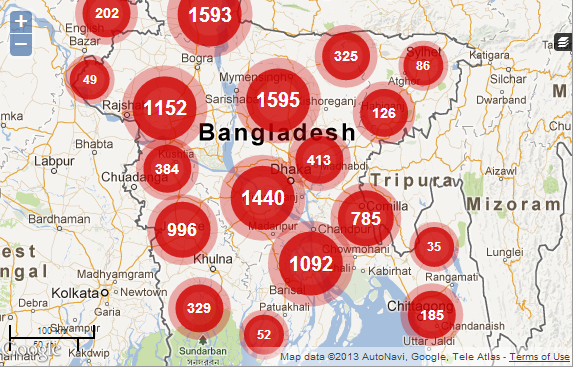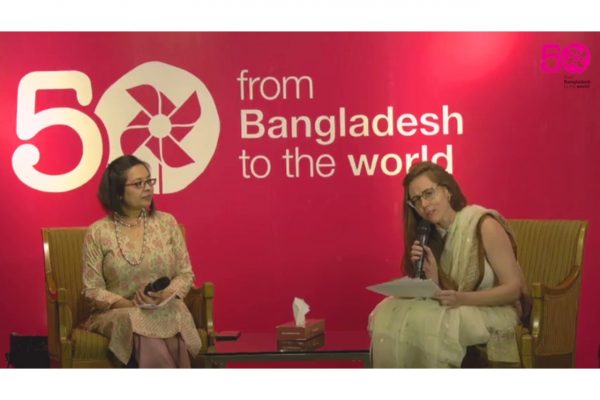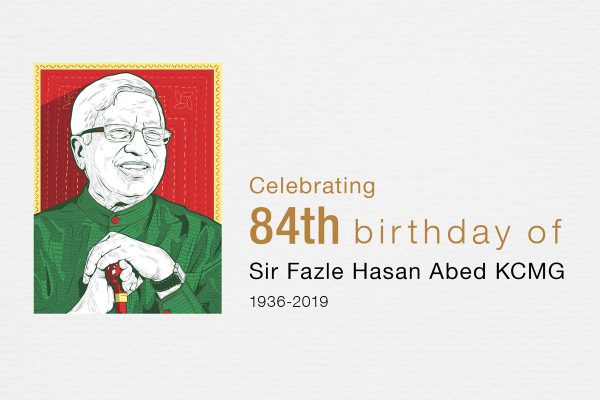Crowdmapping the world we want
Reading Time: 3 minutes
Crowdmapping is an undeniably cool tool in development. It’s amazing that we now can take data from people scattered all over the place, who don’t know each other, and easily consolidate it into a central, often beautiful and transparent website.

A crowdmap of votes in BRAC’s informal, unscientific poll of its community network’s priorities for development after 2015.
Crowdmapping is an undeniably cool tool in development. It’s amazing that we now can take data from people scattered all over the place, who don’t know each other, and easily consolidate it into a central, often beautiful and transparent website.
BRAC often uses crowdmapping, but traditionally it’s the old-school, low-tech style. We sit with community members to draw out important details of a neighborhood: gathering points, extremely poor households, toilets, etc. Often the first draft is drawn in the dirt, and then converted to hard paper form.
 This dialogue of collaborative map making has important social effects that enable BRAC, its volunteers, and community groups to gain support and work more effectively.
This dialogue of collaborative map making has important social effects that enable BRAC, its volunteers, and community groups to gain support and work more effectively.
But what if we could leverage this very solid network of grassroots’ presence for quick, informal polls?
That question confronted us in the middle of a discussion on what the world’s development agenda should be after 2015, post-Millennium Development Goals. We decided to do an experiment—to leverage our community forums to run a non-scientific, nationwide poll.
The open-source, crowdmapping platform, Ushahidi, advertises that it can be set up within minutes. While it took us a little longer, within a week we were prepared to receive responses via SMS and automatically catalogue them by district of origin and vote.
Local BRAC staff members, the program organizers who are always present during these meetings, conducted the poll, spending a few minutes at the end of the meeting to read the question, possible responses, and count the votes. For each meeting, we received just one vote, representing the most popular response. The results immediately came up on the crowd map.
I was on a field visit in Narsingdi the first day that the polls were open. After a full day of visits and meetings, I came back to the regional office, where I promptly opened my laptop to look at the map, and see if there was any activity. Indeed, over 200 votes had already been posted. I thought that was a lot! Little did I know it was just getting started. By the end of the week, we had reached 2,600 votes. A week later, when we closed the poll, we were close to 12,000 votes, conservatively representing over 175,000 participants.
The results are interesting. In each of Bangladesh’s six divisions, education was the top priority, receiving 36 percent of all votes. Health, sanitation, and electricity were tied, each with about 15 percent of votes. Together, these four categories represent about 80 percent of all votes. While there are significant methodological limitations, the emergence of education as a top community priority is supported by other community consultations, such as the UN’s recently published “my world” report, another attempt to making the priority-setting process more inclusive.
Most exciting from my standpoint is that we now have a “new,” easy-to-implement tool of grassroots polling by SMS. Our frontline staff demonstrated that they can execute surveys of this kind. How else can we use this tool to map grassroots ideas, preferences, or events nationally?
It didn’t take long for a second use case to emerge. For the events held on Valentine’s Day (February 14th), BRAC staff and clients participated in the “One Billion Rising” activities, mobilizing people across several countries to demand an end to violence against women. In Bangladesh, we asked staff to count and SMS the number of people who participated in the local events. In each of the 64 districts, our district BRAC representative (DBR) sent an SMS with the total number of participants for his or her district. These went directly to a crowdmap. Within hours, we had calculated that an approximate 2.6 million people had been mobilized in BRAC’s activities across Bangladesh.
What’s the next opportunity to apply this application? I’m not sure, but I’m excited to find out.
What other frugal and powerful tools are out there that we haven’t discovered? If you think you have one, apply to join us at the first Frugal Innovation Forum organized by BRAC’s Social Innovation Lab. The event will take place March 30-31 in Savar, Bangladesh. Don’t wait to apply; the deadline is this Thursday, February 21!
Infographs created by Anjali Sarker.





